Outdoor room heating systems conquer increasingly popular, crowding out traditional wall radiators.
This explains this with excellent technical characteristics. warm floorsFirst of all, a high efficiency (efficiency) and a comfortable, uniform heating of residential premises.
At the same time, due to the novelty such structures, housing owners have many questions regarding the features of their installation and operation. One of them - is it possible to mount the warm floor under the parquet board. Immediately it should be said that there is no unambiguous answer to this question even among professional finishers.
Outdoor heating systems
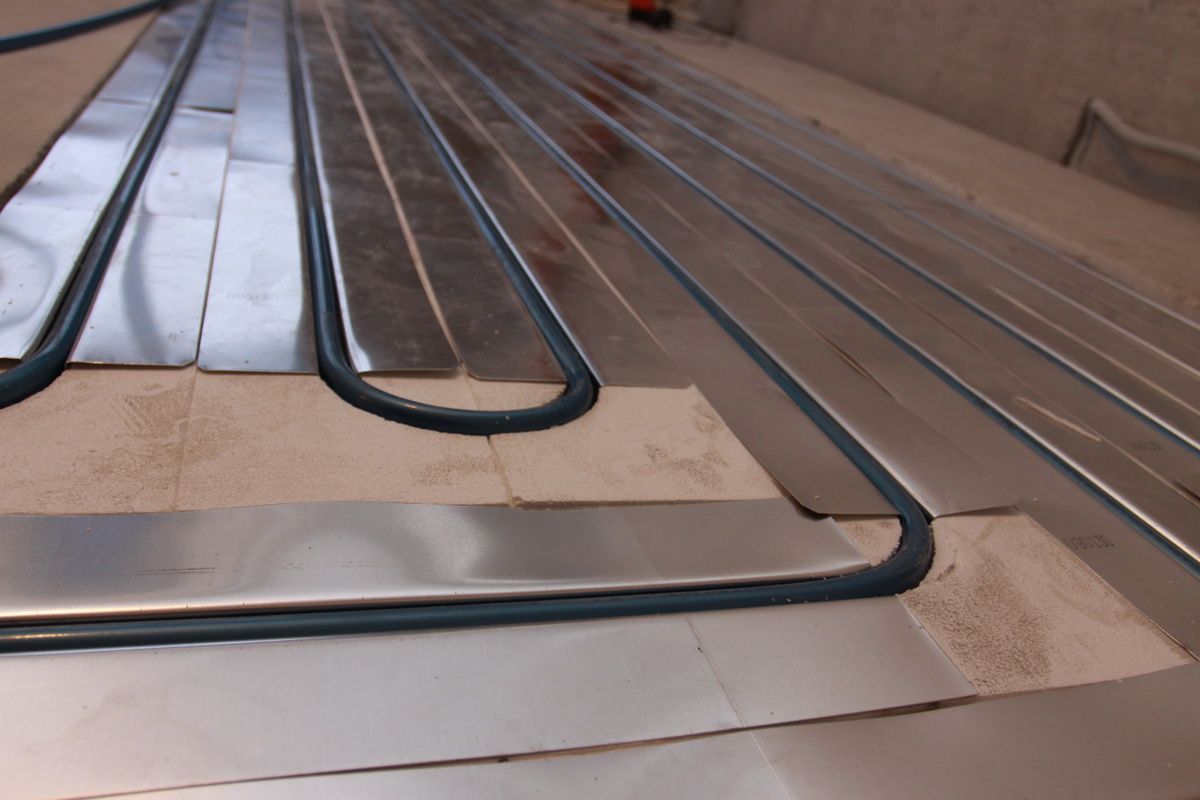 Warm floors are famous for the possibility of uniform heating of the room
Warm floors are famous for the possibility of uniform heating of the room To figure out how compatible with warm floor and parquet board, it is necessary to consider their constructive and operational features.
Outdoor heating attracts to itself, above all, the possibility of uniform warming up the room. Unlike classic heating radiators placed on the wall, warm floors create the most comfortable temperature in the lower half of the room, that is, in the zone where tenants are usually located.
In the case of wall radiators, the air heated by them first rises to the ceiling, and then begins to spread to the bottom. In this regard, the efficiency of outdoor heating systems is significantly higher.
To maintain B. winter time In the room there is a comfortable room temperature, wall radiators must be warmed up to a temperature of 60-80 s, while warm floors will sufficiently heat up to 30-35 C.
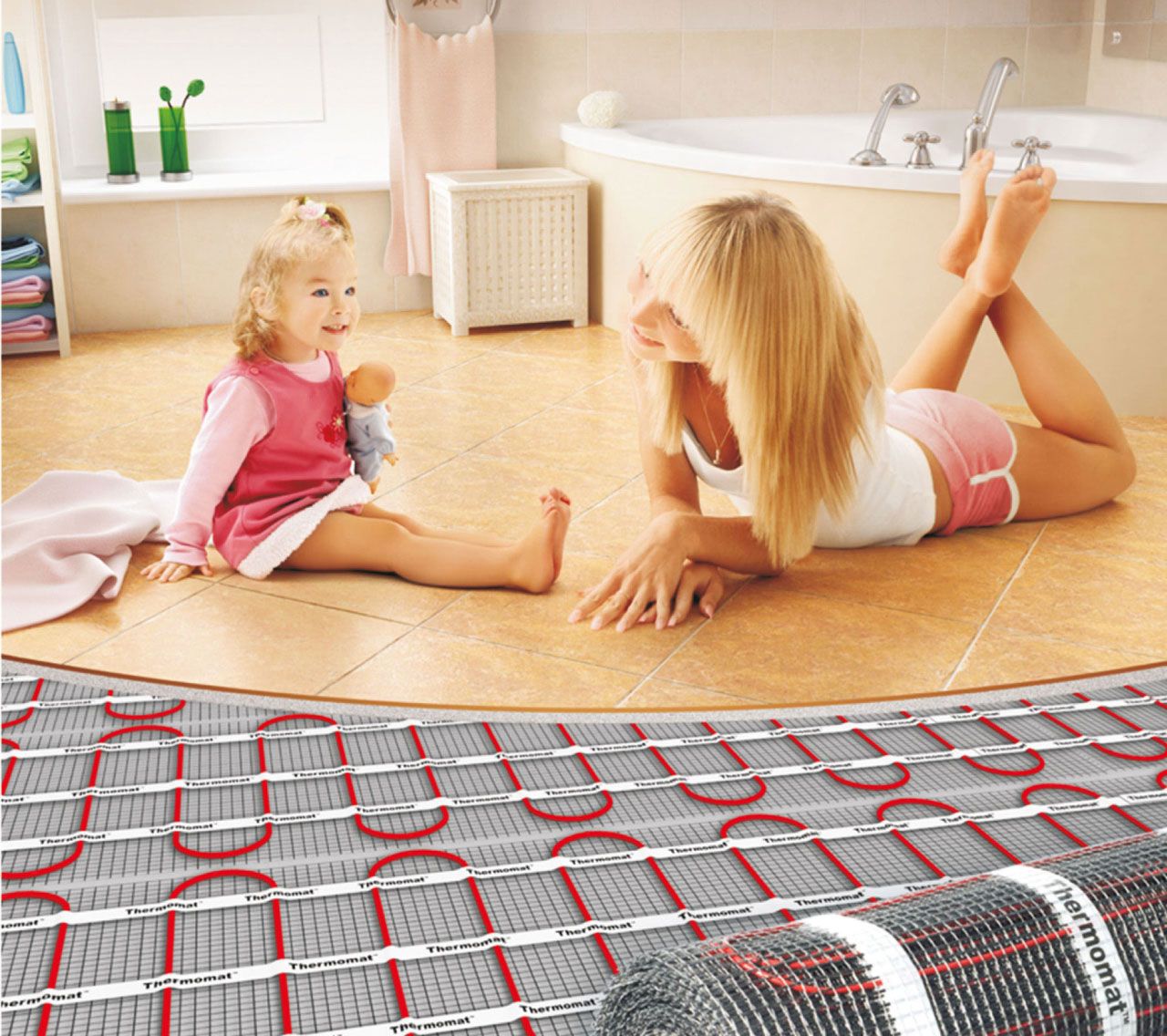 Today, there are three main varieties of warm floors:
Today, there are three main varieties of warm floors:
- Water.
- Cable.
- Infrared.
Each of these systems has its own characteristics, advantages and disadvantages.
Water floors
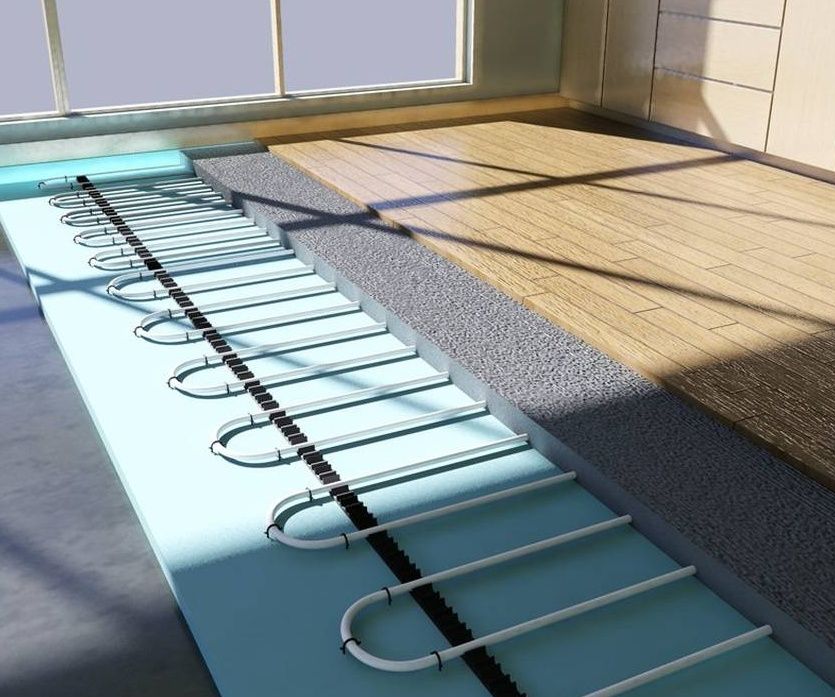 Flexible plastic, from which pipes most often are made, may be deformed
Flexible plastic, from which pipes most often are made, may be deformed The heat source in this case is the heated heat carrier. All heating construction It consists of a water-heating boiler, from which the coolant with circulating nanos is supplied to the system of pipes laid under floor coating.
Most often, flexible plastic protrudes as a material for pipes. Such pipes, in contrast to metal, with external effects are easily deformed, which can create obstacles to normal coolant circulation.
Therefore, water floors after installation are poured by a cement screed, which plays not only the role of protection against physical exposure from the outside, but also heat conductor.
Concrete has very good thermal conductivity, which makes it possible to make it possible to deliver heat from the heating element to the floor covering.
Cable and infrared film floors
 Film floors heat the room itself, while remaining cold
Film floors heat the room itself, while remaining cold This type of warm floors as a source of thermal energy uses electricity. True, there are significant differences in their designs and work.
Cable floors are electrical wires enclosed in an insulating lamp and which are started to heat up under the influence of current. From them heat is transferred to surrounding objects, first of all, flooring.
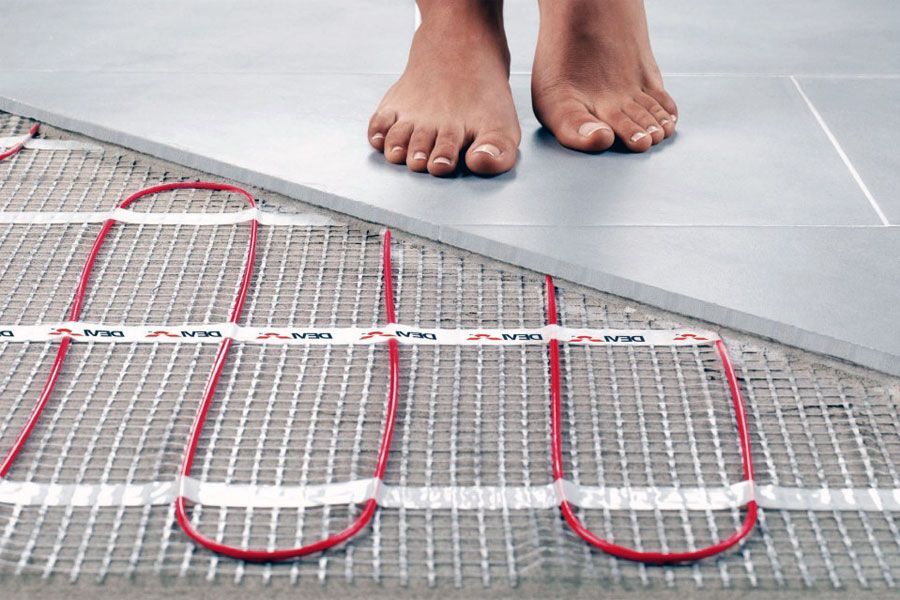 Cable floors for the same reasons as water, poured into a concrete screed, serving "armor", and an increase in the efficiency of the heating system.
Cable floors for the same reasons as water, poured into a concrete screed, serving "armor", and an increase in the efficiency of the heating system.
Film floors also operate on electricity, but infrared radiation is used to transfer heat here. Special graphite heating elements enclosed in a protective film are converting electricity to IR radiation. Through IR rays, heat from film floors is transmitted to the surrounding surfaces.
In connection with such a feature of the work of IR-floor, they are not concluded in a concrete screed. In this case, it can only be used as an aligning base.
Pouring IR film floors concrete screed unacceptable. With this you risk not only to reduce the entire effect of heat transfer, but also irrevocably withdraw the entire heating system.
 IR film is not worth the screed
IR film is not worth the screed As you can see, all outdoor heating systems regardless of their design features have one main trait: initially heats up flooringfrom which thermal energy Transferred to the surrounding air.
In this context, the compatibility of the parquet and a warm floor should be disassembled.
 For the top layer of the parquet board use veneer of valuable wood
For the top layer of the parquet board use veneer of valuable wood
Parquet board, like a warm floor, is a novelty in our market finishing materials. It was created with the aim of improving the performance characteristics of natural wood coatings. Structurally parquet board consists of three parts:
- Bottom layer. It is made of inexpensive, but rather durable wood breeds, most often pine, ate or larch.
- Middle layer. It is a framework of rails or narrow powder, laid by the first layer. It plays the role of the base that fastenses the upper and lower layers of the board. The middle layer is made from coniferous rocks, as well as oak, beech, birch. To reduce the total value of the material for the inner layers of the flooring take the wood of the 2nd grade, since small external defects in this case are not so critical.
- Upper layer. For the facial layer, veneer is taken for expensive trees - oak, Karelian Birch, Ginkgo, Wenge, etc. The main requirements for the outer coating of the floorboard are high aesthetic qualities and resistance to external influence, primarily to abrasion.
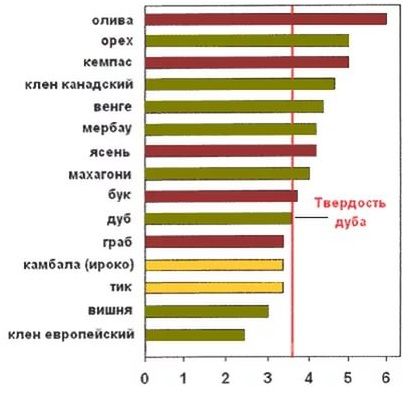
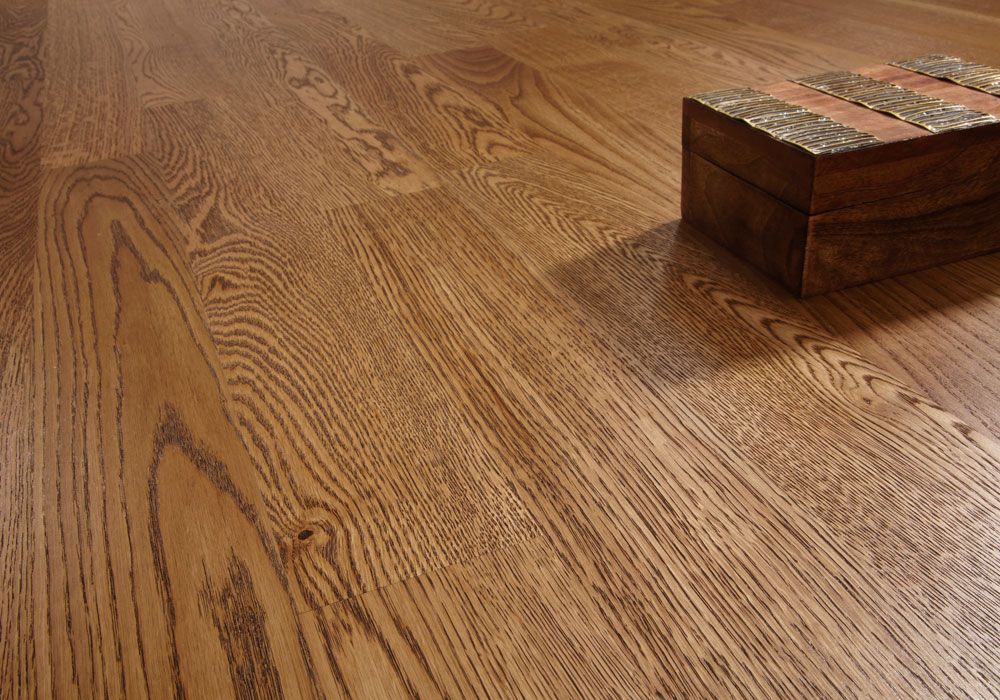 The table shows the relative solidity of various tree breeds used in the production of a parquet board.
The table shows the relative solidity of various tree breeds used in the production of a parquet board.
In addition to the classic parquet board, there are more economical options in our market - a kind of erzat parquet.
In these budget versions, the lower layers of the boards, usually made of natural wood, are replaced with composite materials. Thus, the lower layer is made of chipboard, and the middle - from the MDF. And only the upper decorative layer consists of a natural veneer. Read more about the qualities of the parquet board, see this video:
Accordingly, for the most part, the parquet board consists of natural wood or composite materials based on wood, and since the natural tree is quite a capricious material, laying warm floors under the parquet can ambiguously reflect on the service life of the floor covering.
Laying parquet on warm floors: all "for" and "against"
Professional finishing builders still can't come to a common opinion, whether the forced floor under the parquet board is an acceptable option.
Each party has its weighty arguments "for" and "against" laying the coating of a natural tree on a warm floor.
"Vs"
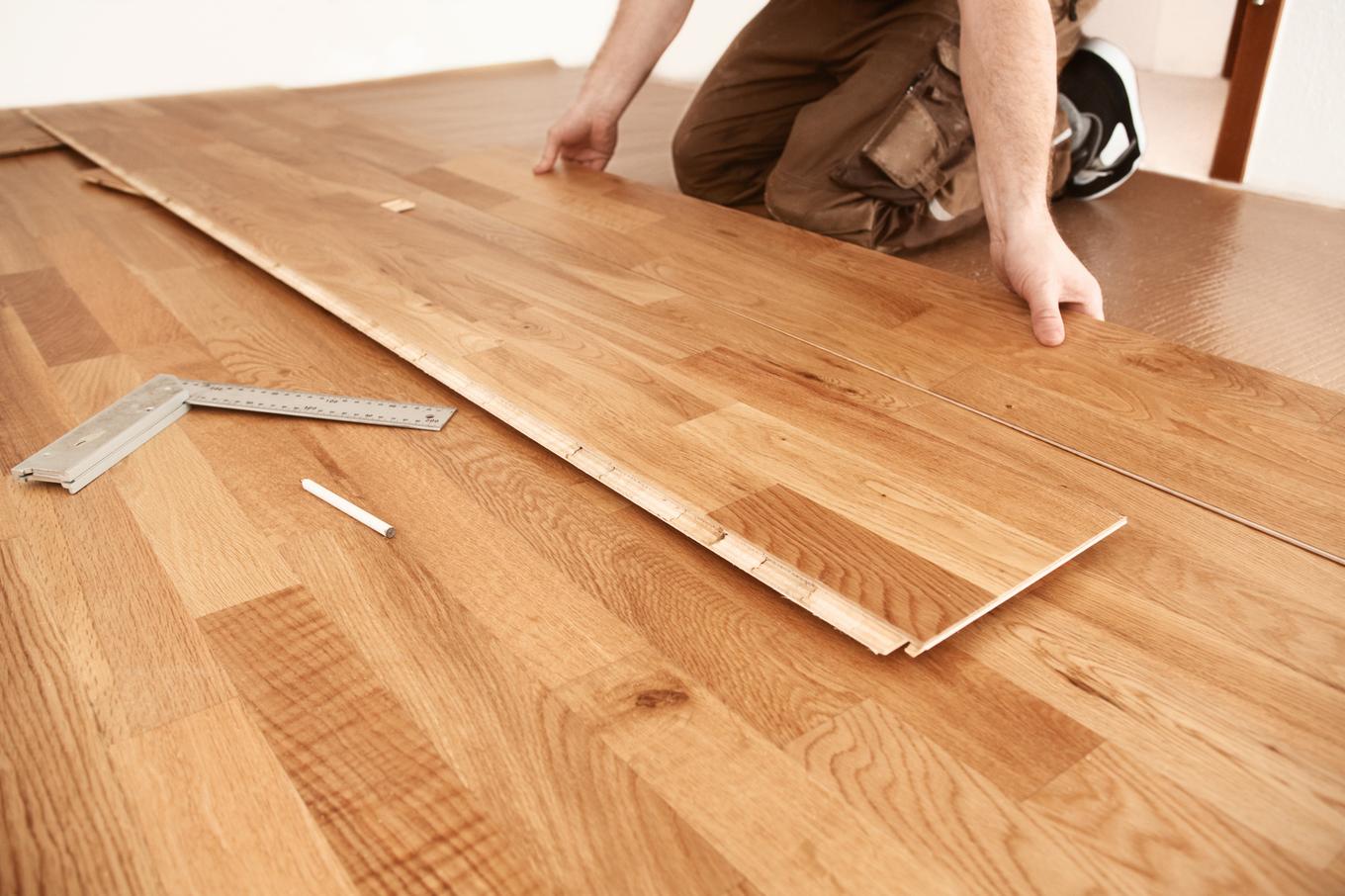 Parquet board does not spend heat
Parquet board does not spend heat First, consider the arguments of those who are categorically opposed to the use of a parquet board for a warm floor.

"Per"
 Parquet board is perfectly combined with a film floor that does not heat up
Parquet board is perfectly combined with a film floor that does not heat up However, in spite of everything, a number of specialists consider the flooring board on top of the warm floors is quite admissible. This follows only to comply with certain rules and recommendations.

As the underlying layer under the parquet board is often used by Faneru. Fastening it to the screed of warm floors should be solely with the help of adhesive compositions.
In no case cannot be used selflessness and dowel-nails: too high the likelihood of damage to the screed water pipes or power electric cabbage. Read more about laying parquet on film floor, see this video:
Having read the features of parquet flooring and floor heating systems, each owner can weigh everything "for" and "against" by choosing the most suitable option.
If you turn to manufacturers wooden floors - It does not matter, massive, engineering or parquet board, the requirements will be as follows:
- the difference between air temperature and the temperature of the warm floor should not be above 2 ° C;
- The maximum temperature of the warm floor should not exceed 26 ° C.
Thus, to really exploit the warm floor with parquet, a long-term neat heating is required with a gradual increase in temperature. The only possible option of such use is the inclusion of heating for the entire cold season. We recommend using a parquet with a warm floor only when it is required for the heating of the room itself (for example, country houses In the style of the step with windows to the floor).
Types of parquet and laying on a warm floor
Massive board can be laid on the warm floor, but difficult. The massive board is attached to the Fan. Phaneur must be shot by a dowel to the screed and problems begin here. You can't know the exact location of the warm floor laying, so the traditional fastening of plywood on the dowels is unacceptable. If you stick to the phaneer on a two-component glue with large slices - it can not be seized, because The glue will save elasticity. You can stick to the paneur to one-component glue - so that no warning starts, the plywood pieces should be the size of no more than 5 × 5 cm and each piece needs to be fixed by cargo. Those. Extremely painstaking and expensive work that high-level specialists can perform.
Parquet on a warm floor laying forbidden. It is added to all problems with plywood bases that even a small alkali of the piece parquet breaks the lacquer coating on the joints and it is impossible to restore it without complete grinding of the floor. Unnecessary risk, because during the operation of a warm floor, no one will regularly check the difference in the temperatures of the warm floor and air. All other types of parquet after the alcohol is restored back (the effect of wood memory).
Engineering board on the warm floor to lay it easier, it solves all the problems of mounting the array. According to the legend, the engineering board based on plywood and appeared for use with a warm floor, because This is a very popular way of heating in Europe. Most engineering boards are available with a spike-groove compound, so when installing it is necessary to fix the planks by the method of harbor until glue solidification to eliminate the slots between the floorboards. Those. Such styling requires a high level of stackers. And it will not be superfluous that the engineering board is laid only on glue.
A sponged parquet board based on HDF is close in structure to laminate, so easily placed on a warm floor.
Nuances that should be known when using warm floors
For use with a warm floor, use parquet from stable breeds - oak, ash, nut. It concerns even a parquet board with a thickness of the upper layer 3 mm. Beech, Maple, Yatoba - breeds that are prohibited for use with warm floors. Refuse to buy any dense exotic breeds. The entire parquet of exotic rocks is supplied to Russia with greater relative humidity than European breeds, and sharply responds to dryness, so when the warm floor is turned on, it starts to dry quickly. The voltage in dense wood is so highly that crawled strips may appear along the entire length of the flooring - it is already impossible to restore it.
Parquet from the facility (squeezes along the edges of the planks) for a warm floor comes better, because It effectively masks a small allen.
It is important to understand that in the parquet (especially parquet board) contains a huge amount of glue, Morilok, varnish - all these compositions must be wounded for health, because When the materials are heated, much more evaporation is highlighted. For example, often manufacturers of an inexpensive level use tinting based on acetone, soaking in ammonia used to give the dark wood. Buy parquet only if you are confident in its environmental safety.
About the system "Warm floor" did not hear unless representatives of the distant African tribe Masai. We also know almost everyone about this wonderful device. However, not everyone knows how this type of heaters can adjourn the flooring. Let's find out if it is possible to use a warm floor under parquet board and parquet? What are the label nuances exist and how useful will be such a tandem?
Warm floor under parquet. If necessary?
Experts in the field of construction and repair differed: Some categorically against the alliance of a warm floor with parquet, others do not see anything wrong with it. Let's listen to the arguments and those and others.
Why not"?
First, wood has a low thermal conductivity coefficient, that is, it can not pass through itself heat. Parquet laid on the "warm floor" simply will not be heated or the process of its heating will occur extremely slow. Thus, the effectiveness of the heating system will decrease to 0, and then there is a reasonable question: "Why is there such a heating structure at all?" Parquet, laid in all the rules and standards, in itself is already an excellent heat-saving element of the house or apartment.
Secondly, wooden planks under the influence of heat eventually begin to develop, cracks will appear and your parquet will begin to "sing songs", as if he has already been 100 years old. The endless creaking, complemented by fused plates with a cracked varnish - this is what awaits you in a year or two. Are these problems of spent money on the installation of a warm floor, if you have to constantly put, correct, cyclish and repair parquet? Probably not!

This will look like a parquet one year after laying it on a warm floor.
Thirdly, you will have difficulty during the warm floor. See. The correct foundation for parquet - plywood. For all construction standards, Faneru must be glued to the screed (so that it is "not walked") with a special adhesive composition, and for greater reliability (you never know) screw it also with self-draws. A small sheet of plywood (50x50) is fixed at least in 8 places, respectively, the more sheet, the more self-sufficiency it will be necessary to use. And now the question? It is possible to spin the screws in such a way as not to touch the power cable (if you use electrical system Heating) or tube (if you chose a water system)? Specify the location of the elements of the heated floor can only be approximately, but it is not necessary to work "on the eye".
Why yes"?
Other experts are confident that the problem is too bloated and the parquet may well coherent with a warm floor, if it is properly put.
They offer for reliable fixation of plywood to use two-component polyurethane glue, which does not require additional fastening with self-draws. But does this glue save the floor from drying out? Most probably not! However, and here the experts found a way out. The thermal insulation material laid under Phaneur will save the parquet from premature aging. And then the question arises again: "Why arrange a warm floor under the parquet, if its heat will still be isolated?" No answer…
With a parquet board, the picture is about the same, but ... some manufacturers are still "allowed" to use their products in combination with the "Heat Paul" system. True, there are several nuances here:
- the temperature at the floor surface must be no more than + 26 ° C;
- the heating of the floor should be uniformly, so that all the slats receive the same "dose" of heat;
- a parquet board should not be made of maple and beech - these breeds "do not like" when they act on heat.
The most optimal heating system in this case will be a system of warm water floors - its heating occurs much evenly than that of electric, and there is almost no sharp fluctuations in temperatures. However, it is plenty with such a design.
Another thing is a film warm floor, which is simple in the installation, and for the parquet board is perfect. Available in several power options, which means it will be possible to choose the one that will be perfectly combined with a parquet board. And you can independently set the desired temperature parameters so that your gender is always "in a great mood."
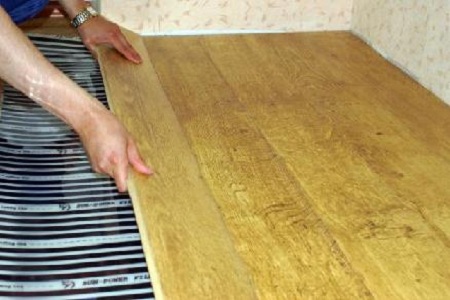
Laying parquet board on infrared warm floor
In addition, the film floors have the following advantages:
- they are thin, which allows them to use them in any premises;
- they are mounted on the ready-made tie, which saves your time;
- they do not "overheat" the parquet board, which does not allow her to dispel;
- they react to the activity or inactivity of other heat sources with a decrease or increasing power, which saves your money.
What have we in the end? Parquet and "warm floor" - still incompatible things, therefore it is not worth spending time and money for useless occupation. A parquet board can be happy with pleasure with infrared and water heating systems. Make repairs with mind!
Many are interested in the question of the possibility of a warm-alone device under parquet. The tree has special properties that require a careful and attentive relationship. In itself, it is a warm material, which is considered a good heat insulator, but sometimes there is a need or wishes of the owner to perform a warm floor under parquet. It is imperative, in this case, to make a competent selection of wood breed, otherwise, after a short period of time, the tree will begin to dispel, the slots will appear, or the flooring is intimidated.
Types of warm sex
Most recently, the floor heated in the apartment was considered a luxury, and his installation could afford not everyone. But progress does not stand still - more affordable materials and technologies that make a warm floor device more accessible are appear. Today, its main types are water and electric.The first option is a heating system running from central heating or from an autonomous boiler. On the concrete base according to a certain scheme laid metal plastic pipes From above thermo reflecting foil, under which the heat insulating gasket is located. Then the entire design is poured by a cement screed, and at least a month later the main coating is mounted.

The step between the pipes is calculated in such a way that the temperature can be distributed most uniformly.
The optimal is the temperature of + 22 ... + 24 degrees Celsius, and the coolant can warm up to +50 degrees.
Water floors are considered less reliable, since the likelihood of their leakage is too large. The reason can be:
- low pipe quality or connecting reinforcement;
- illiterately completed system assembly;
- random damage;
- end of the service life of materials.
Electric warm floor implies gasket under the coated:
- cables (resistive or self-regulating);
- warm mats;
- elastic infrared films.

The heating elements are mounted on the heat insulating layer of a high temperature resistant material, which is placed on top concrete base. Top arrange cement screed And put outdoor coverage. The step between parallel lines of the cable is accepted individually, depending on its characteristics and the type of finishing material.
Control the temperature on the surface of the floor allows the thermostat set above the surface of the floor covering. It is the only visible part of a warm electric floor representing the most progressive heating system.
What to pay attention to
Heated floor can withstand not every tree. The main reason is the change in the initial sizes of parquet dies or boards under moisture influence when changing the temperature regime. It's no secret that the wood makes great absorbing moisture and swells, and when the sweetener is reduced in size and cracks. Therefore, the warm floor under the parquet is recommended to be installed as a last resort, and the coating should be made of wood having a low deformation coefficient and with high water repellent indicators. Specialists offer the following list:
- merbau;
- dossia;
- iroko.
The beech or maple should not be used - they are prone to deformations when changing the microclimate indoors.

Heat the parquet should be carefully, gradually raising degrees on the floor surface. It is important to remember that overheating can lead to negative consequences, so the installation of thermostators to control here is simply necessary. Of course, the gaps that are disappearing in winter between parquet boards. So that they are not too rushing to the eyes, it is recommended to choose:
- parquet thickness not more than 15 cm;
- minimum width parquet board;
- the most elastic glue (polyurethane).
It should be noted that the three-layer parquet board laid on the warm floor behaves a little better. Its structure, namely perpendicular to each other layers do not allow to appear gaps on the surface. In addition, parquet boards "floating" by the method without fixation to the base, and are connected using the Schip-Gaming Castle Fastening. Such a coating is capable of changing its sizes without the occurrence of cracks. But do not forget that a low-quality cheap parquet board may be stamped under the influence of frequent temperature drops.

Since the surface of the parquet is not allowed to warm themselves, it is recommended to use additional heating sources in the room. They can be small radiators, including infrared, or warm walls.
It is necessary to weigh everything well
On the cold floor, it is not very nice to walk, especially in winter. Therefore, carpets are filling in the rooms, and those living use domestic slippers. But to the coatings of wood, including the parquet, this does not apply. Wood itself is quite warm enough, so when I bet on her barefoot no discomfort is not felt.
There are some reasons why specialists are not recommended to mount a warm floor under parquet. We give some of them.
- Thanks to the heat-insulating properties of a natural parquet, work on its heating may be meaningless, since the wood part of the heat simply will not pass.
- The effects of high temperatures on parquet can lead to some problems. Due to the appearance of the slots between the dies, the floor will lose its external attractiveness and will begin to creak. Permanent repair will require physical and material costs.
The output suggests itself. Before the final decision on the arrangement of the warm floor, the parquet will need to take into account many factors, produce the necessary calculations and consult with a professional.
Today, two main varieties of the warm floor are common - electric, in the form of cable, heating mats or films, and water, which is a pipeline that connects to central heating. After you decide on the type of heating system, the time comes to choose an outdoor coating. And here it is important not to be mistaken.
With warm floors, not every type of laminate and especially parquet are compatible. The natural tree reacts poorly to the temperature differences, it dissolves, cracks and deform. Laminate not intended for a warm floor, if it does not lose its commodity type, it may be bad or highlight harmful substances. That is why you need to pay attention to the question of which laminate for the warm floor is to choose. The same applies to the parquet.
Manufacturers produce collections of coatings created specifically for mounting over floor heating systems. On the package you can find the appropriate labeling. In addition, the manufacturer indicates and specificationswho also need to take into account. It is better if you choose a combination of a warm floor and the coating will help you a knowledgeable person.
No matter what you choose, - massive board On a warm floor or laminate for warm water floors. In the studio, Decoracion will help to find a suitable option, which is combined in itself and aesthetics, and functionality. With us, you can be confident in the quality, safety and reliability of parquet and laminate for a warm floor.
Why exactly this parquet board?
- This boards have the best lacquer resistance indicators
- Automated system of sawing, wood preparation and detection of defects.
- This, like almost everything we use, environmentally friendly material.
- The board is covered with 7 layers protective coating, this is another plus in her piggy bank against deformation
- There is nothing more beautiful than natural wood
- A parquet board can be cyclized several times, so that will serve you until you get bored.




